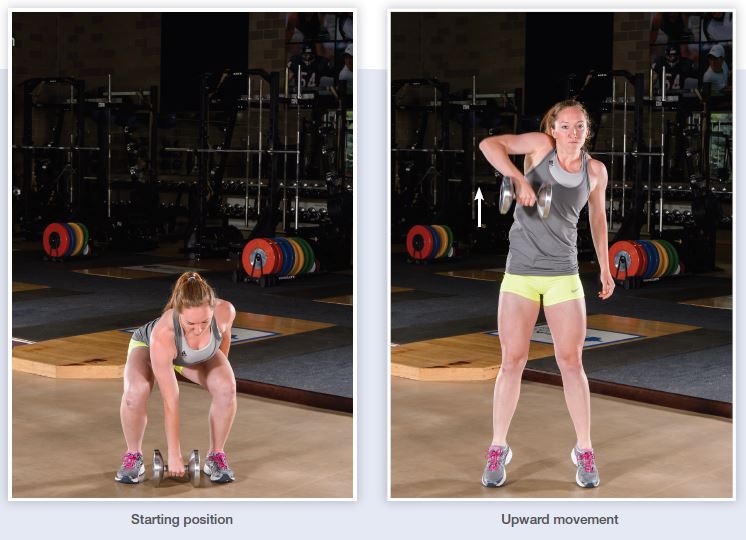One-Arm Dumbbell Snatch
by Exercise Technique Manual for Resistance Training, 3rd Edition With Online Video
Kinetic Select
June 2017
This article describes proper technique for the one-arm dumbbell snatch, which is a total body power exercise.
The following is an exclusive excerpt from the book Exercise Technique Manual for Resistance Training, 3rd Edition With Online Video, published by Human Kinetics. All text and images provided by Human Kinetics.
Starting Position
• Straddle a dumbbell on the floor and place the feet between hip- and shoulder-width apart with the toes pointed slightly outward.
• Squat down with the hips lower than the shoulders and grasp the dumbbell with a closed, pronated grip with the elbow fully extended.
• The arm that is not holding the dumbbell should hang down next to that side of the body.
• Just before liftoff, observe the preparatory body position and lifting guidelines to place the body in the correct position to lift the dumbbell off the floor. All repetitions begin from this position.
Upward Movement
• Begin the exercise by forcefully extending the hips, knees, and ankles (commonly called the triple extension).
• The dumbbell should slide up the thigh, or remain very close to the thigh, as it accelerates upward.
• The elbow of the arm holding the dumbbell should remain extended as the knees, hips, and ankles are extending.
• As the lower body joints fully extend, rapidly shrug the shoulder of the arm holding the dumbbell. The elbow of the arm holding the dumbbell should be extended and pointed out to the side during the shrugging movement.
• As the shoulder reaches its highest elevation, flex the elbow holding the dumbbell to begin pulling the body under the dumbbell. The dumbbell should pass as close to the torso as possible.
• Continue to pull with the arm holding the dumbbell as high and as long as possible.
• The arm that is not holding the dumbbell should remain on the opposite hip or be held to the side.
• Because of the triple extension of the lower body and the pulling effort of the upper body, the torso will be erect, the head will be tilted slightly back, and the feet may lose contact with the floor.

Catch
• After the lower body has fully extended and the dumbbell reaches near-maximal height, pull the body under the dumbbell by rotating the arm and hand holding the dumbbell around and then under the dumbbell and by flexing the hips and knees to approximately a quarter-squat position.
• Once the arm holding the dumbbell is under the dumbbell, extend the elbow quickly to push the dumbbell up and the body downward under the dumbbell.
• The quarter-squat position should be reached with the elbow of the arm holding the dumbbell fully extended just as the dumbbell reaches its maximum height.
• The arm that is not holding the dumbbell should remain on the opposite hip or be held to the side.
• After gaining control and balance, stand up to a fully erect position.
Downward Movement
• At the completion of the repetition, slowly lower the dumbbell from the overhead position by gradually reducing the muscular tension of the shoulder of the arm holding the dumbbell; allow a controlled descent of the dumbbell first to the shoulder, then the thigh, and finally to the floor between the feet, using a squatting movement.
• Reposition the dumbbell and the body for the next repetition, if applicable.
Exercise Technique Manual for Resistance Training, Third Edition With Online Video, explains 70 resistance training exercises with step-by-step instructions, photos, and online video demonstrations. The book is available in bookstores everywhere, as well as online at the NSCA Store.
- Privacy Policy
- Your Privacy Choices
- Terms of Use
- Retraction and Correction Policy
- © 2025 National Strength and Conditioning Association